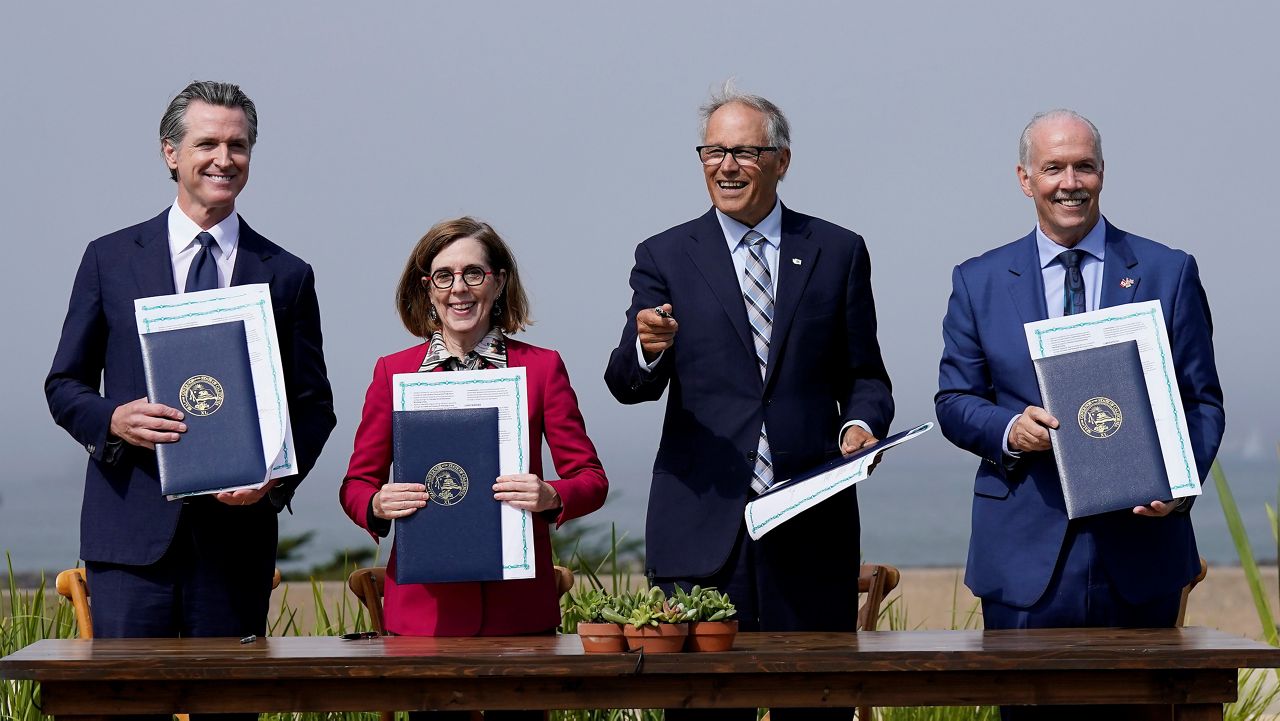SAN FRANCISCO — Following record-setting rainfall in the Pacific Northwest, record-breaking heat in California and wildfires in Western Canada, the governors of all three West Coast states and the premier of British Columbia recommitted to a collaborative climate pact Thursday.
What You Need To Know
- The goal of the Pacific Coast Collaborative is to dramatically reduce greenhouse gas emissions and create a low-carbon regional economy built on transformed energy systems, buildings, transportation and food waste management
- By partnering at the subnational level, they will have a greater impact than they would as individual entities
- All three western states and British Columbia face similar challenges with wildfires that have wiped out entire towns and unprecedented heat that has compromised the electrical grid
- Gov. Inslee said the Pacific Coast’s embrace of clean technologies has helped make it an economic powerhouse
“We recognize with humility we don’t have all the answers, and so we seek to compare best practices,” Gov. Gavin Newsom said Thursday, where he was joined by Washington Gov. Jay Inslee, Oregon Gov. Kate Brown and British Columbia Premier John Horgan in San Francisco to update a memorandum of understanding continuing the Pacific Coast Collaborative.
Formed in 2008, the goal of the Pacific Coast Collaborative is to dramatically reduce greenhouse gas emissions and create a low-carbon regional economy built on transformed energy systems, buildings, transportation and food waste management. The group initially consisted of California, Oregon, Washington and British Columbia but added major cities in 2016, including Los Angeles, Oakland, Portland, San Francisco, Seattle and Vancouver.
By partnering at the subnational level, they will have a greater impact than they would as individual entities.
“We have watched, we have smelled, we have suffered through the smoke. We understand what it is doing to our communities. We understand what it’s doing to the health of our children. We understand it’s an economic disadvantage to our economies,” said Washington Gov. Jay Inslee. “But fundamentally, we are leaders of three states and one province who can see through the smoke to see a clean energy economy which we can build on the Pacific coast.”
Inslee said the Pacific Coast states’ cap-and-trade programs, low-carbon fuel standards and subsidies incentivizing electric vehicles are good models for the federal government to follow as it embarks on its biggest-ever effort to tackle climate change with the recently adopted Inflation Reduction Act.
“We are going to lead to continue to the next steps nationally, because you know what? That’s what the Pacific coast does.”
Inslee said the Pacific Coast’s embrace of clean technologies has helped make it an economic powerhouse. Combined, California, Oregon and Washington account for almost 20% of U.S. Gross Domestic Product, according to the Bureau of Economic Analysis. Specifically, Inslee cited the electric-vehicle charging corridor the three states have collectively embraced for Interstate 5 as they work toward the common goal that all new passenger vehicle sales be zero emissions by 2035.
“These folks are doing the real work. And that’s hard. It’s stubborn to reach these goals. No one should sugarcoat the challenges that present themselves,” Newsom said.
The west coast has “had atmospheric rivers. We had heat domes — terms that we’d never heard of before that have had a profound impact on our people, on our economy and our way of life. And in order to address those challenges, we have to collaborate. We have to work together,” said British Columbia Premier John Horgan. “Nations, subnational jurisdictions, all of us people of the world have to come together.”
Horgan said British Columbia routinely steals best practices that help his province meet its climate goals, including the California Low-Carbon Fuel Standard, which reduces fossil fuel dependency by providing credits for renewable alternatives. It also shares its best practices with wind, solar and other renewable energies “with our brothers and sisters south of the border and indeed around the world,” he said.
“It’s that innovation working with people from every corner of the planet that will get us to where we need to be.”
All three western states and British Columbia face similar challenges with wildfires that have wiped out entire towns and unprecedented heat that has compromised the electrical grid.
“We’ve been in extreme drought eight out of eleven years, so is that the exception, or is that the new normal? We have to do things radically differently. And that’s the spirit that defines this agreement,” Newsom said.
“Don’t fret. Don’t be too anxious. We all turn on the nightly news, and it’s stressful, but these are the antidotes to that anxiety and stress,” he added, noting that California has six times more clean energy jobs today than fossil fuel jobs. “They’re future proofing not just their states, but they’re showing the way for the rest of the United States and folks around the rest of the globe.”



